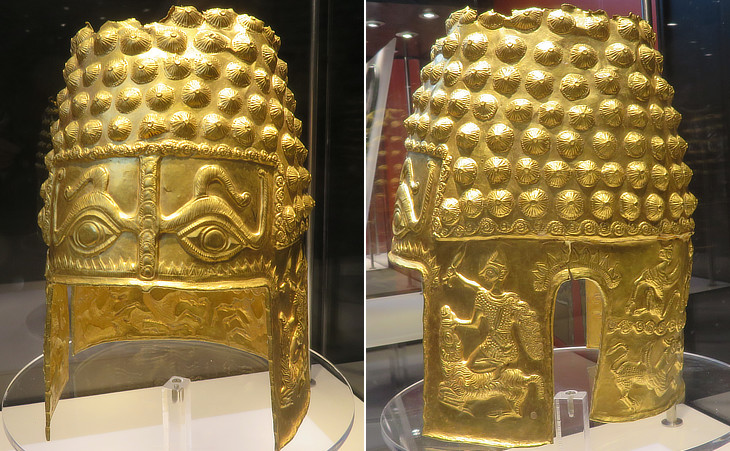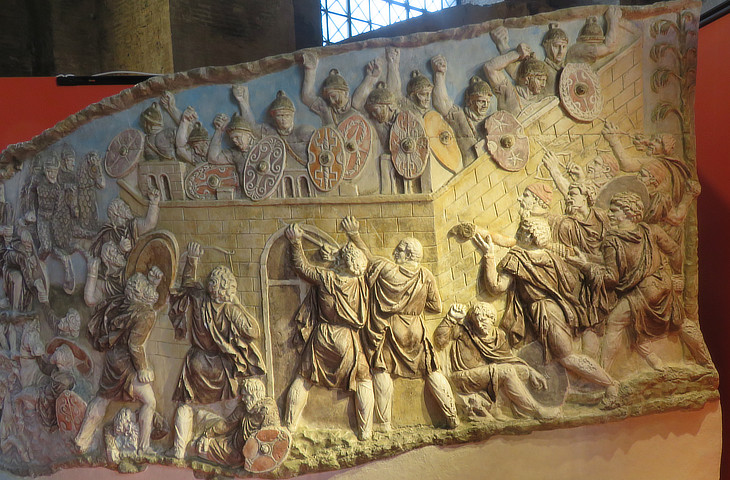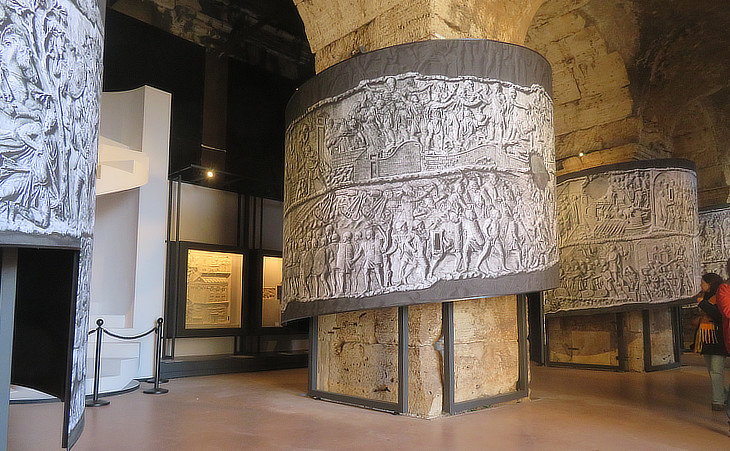Two Roman Wars in the reliefs of Trajan's Column (original) (raw)
 in the reliefs of Colonna Traiana
in the reliefs of Colonna Traiana
You may wish to see Colonna Traiana first. In 97 AD Emperor Nerva appointed co-emperor the general Marcus Ulpius Trajan, who added Nerva to his name and for this reason was regarded as Nerva's adoptive son. The Senate ratified the decision by which for the first time the highest responsibility of the Empire was entrusted to a representative of the provinces (Trajan was born at Italica in Spain). The other remarkable aspect of the decision was the definition of a process for the appointment of the emperors ("succession by adoption") which lasted for more than eighty years and gave Rome some of its greatest emperors: Trajan, Hadrian, Antoninus Pius and Marcus Aurelius.
The emperors who ruled Rome in the Ist century AD had basically a policy of containment of the possible threats to the Empire: in Europe the threat came from the German tribes beyond the Rhine and the Upper Danube, in Asia from the Persian or Parthian empire and in Africa from the Moors. The Roman policy was aimed at reducing these threats by establishing alliances with minor tribes (in Europe and Africa) or kingdoms (in Asia), rather than at expanding the borders of the Empire. Trajan, with the support of the Senate, changed this policy in favour of an expansion of the Empire, also to react to some economical difficulties arising from the cost of the military expenditure.

## Forests in the Eastern Carpathian Mountains near Vatra Dornei in Romania in June 2015 at the presumable northern limit of the Roman province of Dacia
The target of the expansion was Dacia, a kingdom beyond the Lower Danube which included a section of the Carpathian Mountains which were known for their rich gold mines. In today's world Dacia corresponds to most of Romania plus eastern Hungary. In 64 AD Emperor Nero had diminished the gold content of the Roman coins and this had led to financial trouble with coins having the same official name, but different levels of gold.

## 2024 Temporary Exhibition on Dacia at Terme di Diocleziano (see a page on it): gold ceremonial helmet from Cotofenesti, Wallachia: (left) front which is decorated with large studs on the top of the skull and two very large apotropaic eyes, meant to ward off the evil eye; (right) a ram is sacrificed by a king, a priest or a god
The form of the ceremonial helmet shows a local authentic design and it is assumed it belonged to a Dacian king. It was discovered in 1929 and it is dated Vth century BC, but it is likely that the Romans had seen similar stunning gold ornaments in their deals with the Dacians. Trajan thought that the gold of Dacia could help in solving the economical difficulties of the Empire. The Romans had already conquered Dobruja, a region south of the Danube delta, which was part of Moesia Inferior and after Diocletian's reform of Scythia Minor.

## 2024 Temporary Exhibition on Dacia: painted cast of a scene of Colonna Traiana: the Dacians lay siege to a Roman fortress south of the Danube River; they are helped by Sarmatian horsemen (see the following scene)
The war erupted in March 101 and it was justified by raids of the Dacians in the Roman region of Moesia (today's Bulgaria), but Trajan had been preparing the war since 99 when he visited the region and approved the opening of a street on the right bank of the Danube and the fortification of several sites. The Romans defeated the Dacians at Topae, set fire to several towns and moved towards Sarmizegetusa, the capital of the kingdom. At this point Decebalus, the king of Dacia, accepted the conditions imposed by the Romans (which included the disarmament of the Dacian fortresses along the Danube) and a peace treaty was signed. In 105 Trajan declared that Decebalus was in breach of the disarmament clause and sent him an ultimatum. Decebalus reacted by attempting to attack Moesia, but he was repelled and gradually forced to retreat to Sarmizegetusa. The Romans laid siege to the town and cut its water supply. The Dacians eventually surrendered and Decebalus committed suicide. Dacia became a Roman province.

## Pedestal of Colonna Traiana: inscription celebrating Trajan (and the construction of his Forum). Senatus Populusque Romanus Imp(eratori) Caesari Divi Nervae f(ilio) Nervae Traiano Aug(usto) Germ(anico) Dacico Pontif(ici) Maximo Trib(unicia) Pot(estate) XVIII Imperatori VI Co(n)s(uli) VI P(atri) P(atriae) ad declarandum quantae altitudinis mons et locus tant(is ope)ribus sit egestus. The Senate and people of Rome to Emperor Caesar, son of blessed Nerva, Nerva Trajan Augustus conqueror of Germany and Dacia, Highest Pontiff 17 times tribune, 6 times imperator, 6 times consul, Father of the Nation: as an illustration of the height which this hill and place attained, before they were removed for such great works as these
The Dacian wars were celebrated in Colonna Traiana. The reliefs, apart from their artistic value, are an interesting example of war propaganda. Here below a short comment on some episodes described in the reliefs.

## The Roman Fleet leaves Ancona at night and crosses the Adriatic Sea to reach Salona during the Second War
The Roman fleet was made up of triremes, warships with three banks of oars, which allowed them to move regardless of the prevailing winds. The relief shows that Trajan was able to rapidly move across the seas. He is standing on the central trireme while he delivers a speech to the troops. The lamp near Trajan means that the Roman fleet could travel also at night and the high waves and the dolphins mean that the fleet did not move along the coast, but it was capable of crossing the open sea. All these details had the objective of highlighting the Roman capability of rapidly deploying troops in case of conflict. Notwithstanding the fact that Trajan's background was a military one and that he personally led the campaign, the reliefs show him in situations where he is not directly involved in battles. He is portrayed: a) in the ritual ceremonies which preceded the main war events; b) while he delivers formal speeches (adlocutiones) to the troops; c) while he is shown evidence of the Roman victories or he receives the surrender of the enemies. The intent was to put the Emperor on a special footing where he was not involved in the specific events of the war, which as all wars do, had its ups and downs.

## The Dacians, violating the disarmament clause, gather into a fortress
The second Dacian war originated from the violation of a disarmament clause included in the peace terms which ended the first war. The relief shows the "smoking gun" i.e. the purported violation of the clause. We see the Dacians wearing weapons and gathering inside a fortress. The slightly taller man inside the fortress is Decebalus, the king of the Dacians: while the viewers were able to identify Trajan by his face, his opponent was made identifiable by his height. The costumes of the Dacians show that the Romans did not consider them a savage population, because they are shown wearing elaborate dresses and a hat. Eventually the "Dacian prisoner" was portrayed also in Roman monuments celebrating military campaigns which were not related to Dacia, e.g. at Arco di Settimio Severo.

## Coalition forces: Chivalry of the "Moors" and of the Sarmatians
No monument gives the complete and real costume of its kind so correctly as this column. (..) In relating the two wars, this column sets each nation in contrast: here the Moorish horse all naked and unharnessed; there the Sarmatians in complete mail down to the fingers and the hoofs. It exhibits without embellishment all the tactics of that age. Joseph Forsyth - Remarks on antiquities, arts, and letters, during an excursion in Italy in 1802-1803 In addition to Romans and Dacians the reliefs show some other troops: on the Roman side the relief above (left) shows the chivalry of the Moors (see pages on Roman Morocco, Algeria and Tunisia): the viewers were able to identify them by their frizzly (almost "rasta", see also a sarcophagus at Lyon) hair and by the fact that they rode without saddle. In other episodes the Romans are helped by German warriors (almost naked and with moustaches) and by archers wearing an elaborate Oriental costume. The fact that we see on the Roman side representatives of their fiercest enemies may mean that Rome was at peace at that time, that the borders of the empire were secure and that the Dacian war had the support of the whole world. On the Dacian side the reliefs show the Sarmatian chivalry: both the warrior and the horse wear a reptile-like scale armour. It is interesting to note that immediately above the relief showing the arrival of the Sarmatians, we see the body of a dead Sarmatian chevalier. In this way the viewer immediately sees the end of the enemies of Rome. This "trick" is used also in other episodes showing the Dacians on the attack and, immediately above this scene, their dead bodies or their rout. The Sarmatians lived in the vast plains of Ukraine.

## Securing the advance: legionaries at work; see a relief showing them activating a war engine and another one showing the bridge they built over the Danube
In 9 AD Arminius, a German officer in the Roman army, convinced General Publius Quinctilius Varus to make a punitive expedition against the tribes who from time to time threatened the Roman colonies in the Rhine valley. Three Roman legions marched well into hostile territory and following the advice of Arminius they entered the deep Teutoburg forest (near today's Detholm). At this point Arminius abandoned the Romans and the Germans of his tribe (the Cherusci) attacked the legions in a series of ambushes. The Romans were unable to move in the forest and to use their superior military skills and equipment. The Germans spared just a few legionaries to let them bring the news to the Roman oupostss. The head of Varus was sent to other German tribes to promote a general rebellion against the Romans. Eventually the head was sent to the Romans. According to Suetonius, Emperor Augustus cried out: Vare, legiones redde! (Varus give me back my legions). Seven years later the Romans took their revenge and Arminius was defeated by Julius Caesar, a nephew of the Emperor Tiberius, who is generally known as Germanicus, the additional name he was given for his victory. In the XIXth century Arminius was hailed as a national hero and a precursor of the German nation. The defeat suffered by Varus had lasting consequences on the Roman expansion in Europe and its memory can be seen in the numerous reliefs of the column which show Roman legionaries in the act of cutting down trees and building fortified camps, reliefs aimed at reassuring the viewers that Trajan was not repeating the mistakes made by Varus.

## After the battle: prisoners and wounded soldiers
Some reliefs show the aftermath of war: Dacian prisoners are shown while they are being tied and blindfolded. The prisoners show a rather submissive attitude as if they were agreeing to these actions. The reliefs do not show casualties on the Roman side, but some of them show Roman legionaries taking care of wounded soldiers who are helped to walk or are bandaged.

## Surrender
This column is an immense field of antiquities, where the emperor appears in a hundred different points, as sovereign, or general, or priest. His dignity he derives from himself or his duties; not from the trappings of power, for he is drest like any of his officers: not from the debasement of others, for the Romans, all save one, kissing his hand, stand bold and erect before him. Forsyth The first Dacian war ended with a peace treaty: the event is celebrated in a very complex scene where we see desperate Dacians pleading for mercy, after having thrown away their weapons. The Dacians are not portrayed as enemies, but rather as persons converted to a new faith. The relief shows the need for the winner to see his actions justified by the confession of those who surrender that they wrongly acted. The viewer is shown a religious ceremony and the processions of Romans and Dacians are both converging towards Trajan in the act of saying Pax (peace). The verticality of the Roman military symbols balances the horizontal lines of the processions. On the left side the viewer sees the heads of Roman legionaries carrying bags and moving away from the scene: the first Dacian war was not meant to conquer Dacia, but just to curtail its power, so having achieved their objective the Romans are already leaving the occupied country.

## Museo della Civilt� Romana (temporary exhibition at Mercati di Traiano): model of "Tropaeum Traiani", a monument built in 109 to celebrate Trajan's Victory at Adamclisi, a village in Dobruja
In the year 271 AD Emperor Aurelian, the emperor who built the walls of Rome, decided to move out of Dacia, because it was too difficult and expensive to protect that province from the raids of barbarian tribes.
The image in the background of this page shows Victory (not Truth) writing the history of the Dacian wars. You may wish to see the triumphal arches celebrating Trajan at Ancona and Benevento.

## Panels of a 2024 temporary exhibition devoted to Colonna Traiana at Colosseo